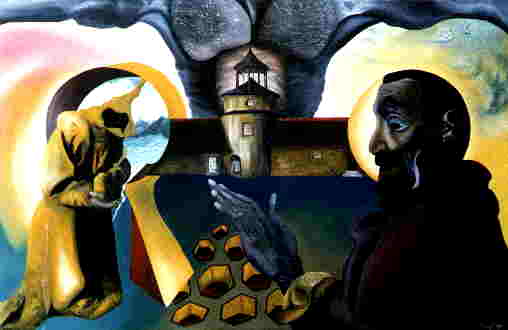The painting represents the transition from a deep, habitual, religious belief to the opposite end of the spectrum: the abandonment of all faith, vows and principles.

The apostates mind's eye has become the repository of all the ungodliness man has bestowed upon man through his beliefs.
There are three figures, three windows, three doorways and three ghoul like figures. Three, as in trinity, being symbolic of the union of three persons in one Godhead.
The rules of behaviour are studied in the field known as Cellular Automata. Here we program a matrix of individuals, each with a specific behaviour rule. Generally these are all the same, corresponding to a unified society, and we monitor the global behaviours that result. Many different rules are possible and each gives a corresponding form of behaviour. Many degenerate into fixed behaviours, either static or repetitive, unable to adjust to new conditions, these can only to return to the behaviour of the past. Some instead generate chaotic behaviours, an anarchic state where chaos reigns. The most interesting allow a diverse range of behaviours. Where individuals follow different rules the evolutionary possibilities increase, allowing the creation of new behaviours, emergent novelty.
In a fixed rule society, a novel mutation is often supressed. 'Different' people are persecuted, yet often this is just what is required for progress. In any system the distribution of possibilities falls each side of the average. For any dangerous deviation from the norm there will equally occur an advantageous one. If we fail to recognize the difference, then we consign our society to stagnation and decay...